|
Ever
since the birth of Islam, the Islamic world has had a
great fondness for the written word. Most Muslims in
those times, possessed a copy of the Holy Qur'an, and
there were many well-stocked public libraries. By about
1000 CE the public and university libraries of Cordoba,
of Muslim Spain had accumulated over 140,000
manuscripts. At the same time, the Vatican Library the
largest in Christian Europe contained less than one
thousand. The Muslims had certain knowledge of printing
from the tenth century onwards, but they preferred a
handwritten manuscript of the Holy Qur'an to the printed
text. And, they expected the utmost refinement of
elegance in all their manuscripts, both in calligraphy
and the accompanying geometrical designs and paintings.
The art of calligraphy was
encouraged by contemporary taste and also by the
availability of excellent paper, which was used by the
Muslims from the tenth century onwards. The use of
miniatures was limited due to the Islamic prohibition
against creating images, which meant that no copies of
the Holy Qur'an were ever illustrated, and its pages
were decorated by geometrical designs. Consequently, the
services of miniature painters were used for chiefly
secular purposes, and they worked under the patronage of
emperors, kings, and wealthy private citizens.
The first notable
centers of miniature paintings were set up under the
Abbasids and Seljuk Turks, at Mosul and Baghdad. There
the earliest illustrated texts were for the translations
scientific treatises meant for the scholars, to
illustrate works on subjects such as medicine,
geography, botany etc. As early as in the tenth century,
miniatures for astronomical texts have been produced in
Herat. Later, books of stories and fables were
illustrated, and these gave ample scope for the
development of miniature paintings. In the course of its
evolution of the manuscript, the illustrated page
assumed characteristic features. Geometrical patterns
bordered each page, or sometimes surrounded two facing
pages so as to obtain more space for paintings. However,
the copies of the Holy Qur'an continued to be written
without using any images and were filled with borders of
complicated geometrical patterns.
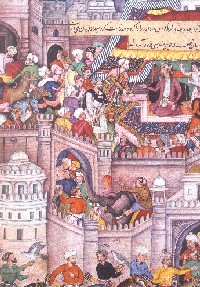 |
|
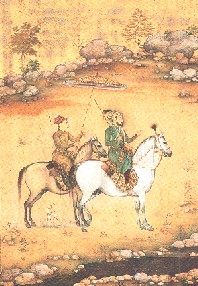 |
|
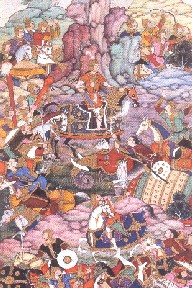 |
|
Illustration from Babar - Nama showing a scene from
the life of Princess and military heroes seated in
Mughal court |
|
Mughal miniature painting of Shah Jahan riding with
his eldest son Dara Shikoh painted by Govardhan |
|
Mughal miniature painting of a battle in progress
painted by Govarhan |
After the
Mongolian conquest by Timur, the Muslim miniaturists
were introduced to the Chinese models and techniques of
painting and were greatly influenced by them. They
started using colors in a wide variety of shades and
were given an intense luminosity. Such elaborate borders
surrounded the paintings that were done in the center of
a manuscript that no empty space was left. By the end of
the fourteenth century, important schools of paintings
sprang up in the cities of Tabriz, Shiraz, and Herat,
under Royal patronage. Bihzad was considered as one of
the greatest master painters of this time. Under the
descendants of Timur, painting continued to develop and
flourish and it was one of his descendants who brought
with him the art of miniature painting to India. By this
time, the Chinese element in the paintings had been
completely assimilated to become a Persian original.
The Mughal
miniature art of painting owes its introduction into
India to the artistic genius of two Mughal emperors,
Humayun and his illustrious son Akbar. Humayun had been
driven out of India by his rival Sher Shah and was
forced to seek refuge for one year in the court of Shah
Tahmasp (1524-76 CE) of Persia. Shah Tahmasp was an
enthusiastic patron of painting and maintained in his
court a large retinue of painters, and among them was
the master painter Mirak. During his time as a refugee,
Humayun spent a great deal of time at the studios of
Tabriz inspecting their works. Humayun returned from
Persia with a high sense of appreciation for pictorial
art, convinced of its great cultural value.
Among the
painters whom he met at Tabriz, he was especially
impressed by the work of two young artists, Mir Sayyid
Ali Tabrizi and Khwaja Abdu's-Samad Shirazi. When
leaving Tabriz, Humayun promised employment as soon as
he was in a position to maintain a court of his own.
After a few years, Humayun wrested control of Kabul from
Kamran and the two painters came and joined his service
in the year 1550 CE. They were entrusted with the job of
illustrating Dastan-e-Amir Hamza, which was to
consist of twelve volumes of one hundred folios each,
and each folio was to contain an illustration. In this
way, the future foundation of the Mughal School of
painting was laid.
The Emperor did
not live to see his Dastan fully illustrated. He died
suddenly in 1556 CE and was succeeded by his
thirteen-year old son Akbar. The first few years of
Akbar's life were spent in wars, and consolidating his
hold over the Mughal empire and there was little time
left for him to cultivate or patronize art and
literature. But, a new era set in with his magnificent
project of converting an obscure village of Sikri into a
full-fledged city complete with palaces and buildings
for himself and his nobles. He soon shifted his capital
from Agra to Fathepur Sikri. After the conquest of
Gujarat in 1572 CE, Sikri was named Fathepur and there
Akbar founded the Mughal School of miniature painting.
Khwaja Abdu's-Samad, who is reported to have given Akbar
lessons in the art of drawing, when he was a young
prince, was appointed as head of the school, and under
him the school developed into a full-fledged
institution.
According to
Ain-e-Akbari written by the court historian Abu'l
Fazl, a separate department was created to look after
the needs of the painters and a supervisor appointed to
submit a weekly progress report to the Emperor and the
requirements of the school. Good quality paper and fine
brushes were imported from Persia at high prices. Akbar
would inspect the finished art of his painters every
week and would reward painters for the excellence shown
in their works and had their salaries increased on
merit. Under Akbar's care, the paintings received the
highest form of perfection. The minuteness for detail,
the general finish, and the boldness of execution
observed in the paintings were comparable to the
wonderful works of the European master painters who had
achieved worldwide fame.
The activities of
the Mughal painting during the greater part of Akbar's
reign were confined to book illustrations. The
illustrations of Dastan-e-Amir Hamza, which had begun
under Humayun was completed in 1575 CE in the same
Persian style, and the whole series contained 1375
paintings forming its illustrative portion. The
Babar-Namah (the Autobiography of Babar), the
Darab-Namah (a book of stories and anecdotes from
the celebrated Persian classic the Shah-Namah,
the Timur-Namah and the Baharistan of Jami
were among the several other classics that were
illustrated in Akbar's time. The Hindu epics were also
translated into Persian and illustrated under the
supervision of Hindu artists. A major portion of the
book illustrations done in the earlier stages followed
the Persian style of painting. It is on this account
that the Mughal paintings of the earlier times are often
referred to as "the Indo-Persian miniatures."
However, it was
not long before the Indian artists learnt the art of
wielding the brush that they began to assert themselves
by making a gradual departure from the Persian style of
painting to exhibit their skills in the traditional
Indian style. The Mughal paintings had reached the
zenith of their perfection by the time of Jahangir's
accession to the throne. His interest in art was of a
more intense nature. He was a born lover of painting and
he could draw as well. The best specimens of Mughal
paintings were executed under his reign. In his memoirs
the Emperor speaks about his love for paintings and his
accomplishments in judging and grading different
specimens. He writes: "I am very fond of pictures and
have such discrimination in judging them, that I can
tell the name of the artist, whether living or dead. If
there were several portraits finished by several
artists, I could point out the painter of each. Even if
one portrait were finished by several painters, I could
mention the names of those who had drawn different
portions of the single picture…"
The first signs
of decline of the Mughal paintings began to appear
during the reign of Shah Jahan. It was perhaps due to
the Emperor's leanings towards architecture. This
affected the school, which from its beginning was
dependent on court patronage. The number of artists
began to decline by the day. A few left the school to
seek employment elsewhere. The quality of workmanship
suffered. In the selection of the subjects the painters
inclined more towards presenting the strange rather than
the beautiful. The freshness, vigor and spontaneity of
the earlier paintings were substituted by over
elaborations, and a profuse use of gold.
The Mughal
paintings suffered a further decline under Aurangzeb, as
they had no aesthetic appeal to the Emperor, who
encouraged Arabic calligraphy as a form of art, in which
he held an eminent position. The painters unlike the
musicians were not altogether banished from the court,
but their number was reduced to the barest minimum.
Aurangzeb maintained a few master artists in his
employment to make use of their services strictly for
painting battle scenes and accompanied him on his
military expeditions to the Deccan, where the Emperor is
seen occupying a central position in the paintings
during his wars and besieging important fortresses. And,
with the death of Aurangzeb the Mughal school of
paintings that was patronized by the earlier Mughal
Emperors came to an end.
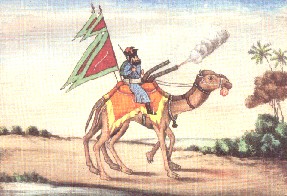 |
|
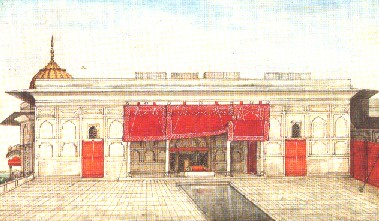 |
|
Camel artillery men |
|
Oratory - Tasbee H Khana
in Red Fort, Delhi |
From its very
beginning, painting has been an Imperial art and had
always been dependent on the favors of the Royal Mughal
Court. It enjoyed no support with the masses because it
was not a popular art. The remaining one hundred and
fifty years of the later Mughals until their downfall in
1857 CE were years of intermittent civil wars, chaos,
and uncertainties. The Later Mughals were too weak to
maintain their position, and they could not afford to
give the art the amount of attention it needed and once
the imperial patronage was denied, it ceased to exist.
A study of Mughal
miniatures, which were done during the time of Akbar
show court scenes where the Emperor occupies a highly
ornamented seat on a balcony that was raised above the
courtiers and crowds below. Jahangir's love for
paintings surpassed that of his father. He had always a
number of painters waiting upon him to draw the likeness
of anything that might please him. He also had number of
portraits done of himself form his early youth and in
his old age. Under Shah Jahan emphasis was laid on
single portraits. The individual portraits done during
his time show full-length figures of the emperor
standing in rigid profile, showing only half of the
face. The original Persian style of painting three
quarters of the face was totally given up in favor of
the Indian style, which showed only half of the face.
Khwaja 'Abdu's-Samad
and Mir Sayyid Ali were the two great portrait painters
during Akbar's time. Among artists of Indian origin
Dashwanth and Basawan were rated highly as portrait
painters. The master portrait painters of Jahangir's
court were Farrukh Beg, Muhammad Nadir, Aqa Raza and
Bishandas. Referring to the excellence of Bishandas as a
painter, Jahangir records, "At the present time he has
no equal or rival…" Shah Jahan's famous court painters
were Muhammad Faqiru'llah Khan, Mir Hasan, Anup Chitra
and Chintamani.
The Mughal
miniature is sometimes also called a masculine art.
However liberal minded the Mughal emperors might have
been in other respects, they were very conservative as
far as their harems were concerned. There is no proof
that the two most prominent Mughal ladies Nur Jahan and
Mumtaz Mahal appeared before artists to get their
portraits painted. Therefore, the portraits attributed
to the ladies cannot be accepted as genuine. Some
drawings of dancing girls and maid servants can be seen
in other Mughal paintings, which are good specimens of
female portraits and show the richness of imagination of
unknown artists who drew them.
Other paintings
show the emperor on a hunt, crossing a raging river on
the back of an elephant. There are pictures of dervishes
dancing in ecstasy; animals and birds also occupy an
important position in the Mughal paintings. Mansur was
considered to be the best painters of the animal and
bird kingdoms and served under both Akbar and Jahangir.
Paintings of important Mughal buildings, monuments and
mausoleums done by unknown artists have been preserved
even to this day.
The Mughal
miniatures, patronized by the Mughal Emperors was by its
very nature a secular art. The empire of the Mughals has
long disappeared, but the works of the master-painters
of their time still bear testimony to their refined
tastes and their contributions to the Indo-Muslim
culture and have won worldwide appreciation. The Mughals
occupy a unique position among all the rulers of Asia as
patrons of arts and learning and this is precisely the
reason that their fame extends not only among the
Indians but also thousands of people living outside the
Indian sub-continent. |
